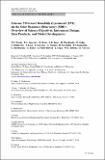Extreme Ultraviolet Variability Experiment (EVE) on the Solar Dynamics Observatory (SDO): Overview of Science Objectives, Instrument Design, Data Products, and Model Developments
Author(s)
Hock, R.; Woodraska, D.; Judge, D.; Didkovsky, L.; Lean, J.; Mariska, J.; Warren, H.; McMullin, D.; Chamberlin, P.; Bailey, S.; Fuller-Rowell, T.; Sojka, J.; Viereck, R.; Woods, T. N.; Eparvier, F. G.; Jones, A. R.; Tobiska, W. K.; Berthiaume, Gregory D; ... Show more Show less
Download11207_2009_Article_9487.pdf (2.035Mb)
PUBLISHER_CC
Publisher with Creative Commons License
Creative Commons Attribution
Terms of use
Metadata
Show full item recordAbstract
The highly variable solar extreme ultraviolet (EUV) radiation is the major energy input to the Earth’s upper atmosphere, strongly impacting the geospace environment, affecting satellite operations, communications, and navigation. The Extreme ultraviolet Variability Experiment (EVE) onboard the NASA Solar Dynamics Observatory (SDO) will measure the solar EUV irradiance from 0.1 to 105 nm with unprecedented spectral resolution (0.1 nm), temporal cadence (ten seconds), and accuracy (20%). EVE includes several irradiance instruments: The Multiple EUV Grating Spectrographs (MEGS)-A is a grazing-incidence spectrograph that measures the solar EUV irradiance in the 5 to 37 nm range with 0.1-nm resolution, and the MEGS-B is a normal-incidence, dual-pass spectrograph that measures the solar EUV irradiance in the 35 to 105 nm range with 0.1-nm resolution. To provide MEGS in-flight calibration, the EUV SpectroPhotometer (ESP) measures the solar EUV irradiance in broadbands between 0.1 and 39 nm, and a MEGS-Photometer measures the Sun’s bright hydrogen emission at 121.6 nm. The EVE data products include a near real-time space-weather product (Level 0C), which provides the solar EUV irradiance in specific bands and also spectra in 0.1-nm intervals with a cadence of one minute and with a time delay of less than 15 minutes. The EVE higher-level products are Level 2 with the solar EUV irradiance at higher time cadence (0.25 seconds for photometers and ten seconds for spectrographs) and Level 3 with averages of the solar irradiance over a day and over each one-hour period. The EVE team also plans to advance existing models of solar EUV irradiance and to operationally use the EVE measurements in models of Earth’s ionosphere and thermosphere. Improved understanding of the evolution of solar flares and extending the various models to incorporate solar flare events are high priorities for the EVE team.
Date issued
2010-01Department
Lincoln LaboratoryJournal
Solar Physics
Publisher
Springer Netherlands
Citation
Woods, T. N., F. G. Eparvier, R. Hock, A. R. Jones, D. Woodraska, D. Judge, L. Didkovsky, et al. “Extreme Ultraviolet Variability Experiment (EVE) on the Solar Dynamics Observatory (SDO): Overview of Science Objectives, Instrument Design, Data Products, and Model Developments.” Sol Phys 275, no. 1–2 (January 12, 2010): 115–143.
Version: Final published version
ISSN
0038-0938
1573-093X